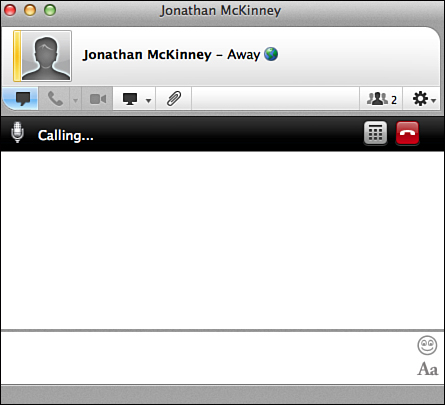Audio/Video Calls and Conferencing
One of the more interesting features in the
Microsoft Lync:Mac client is the capability to participate in audio or
video conferences with other users of the Lync Server 2013 environment.
Before the first participation in either an audio conference or a video
conference, users should configure their audio and video devices in the
audio and video device preferences section. After these devices are
configured, a user is ready to start the first conference.
For purposes of this section, view a
call and a conference as essentially the same event, with the only
difference being the number of parties involved. If two parties are
involved, it’s a call. If more than two parties are involved, it’s a
conference. Generally, the steps are identical for initiating and
managing both. Whenever the steps vary, they are called out as such.
Making an Audio Call
Initiating an audio call is as simple as
clicking a contact and selecting the call option, which is a retro
microphone icon as shown in Figure 1
After this is done, the contact receives a pop-up and an audio
notification and has the option to answer, decline, or redirect. Answer
and decline are obvious in what they do. Redirect gives the option to
reply through IM or to set one’s status to Do Not Disturb. Accepting
the call updates both users’ status to In a Call.

Figure 1. Initiating a call.
If you’re already in an IM conversation, you
can add audio by clicking the telephone icon and choosing how you’d
like to reach the person—either via Lync call or over the PSTN. A call
connecting is shown in Figure 2.

Figure 2. Calling a Lync contact.
Making a Video Call
Initiating a video call is as simple as
clicking a contact and then selecting start a video call. Much as with
the audio call, the recipient has the option to accept, decline, or
redirect. Redirect gives the option to reply with an IM as well.
When the call is accepted, the usual client
window opens in the Video view. The recipient initially sees the caller
but the caller won’t see the recipient until she clicks Start My Video
in the window. By default, each participant in a two-way call sees
herself in a picture-in-picture window inside the main video window.
The picture-in-picture can be moved anywhere within the video window
and will not block access to the following buttons. You can modify the
picture-in-picture, also called the preview, by right-clicking it. This
gives the options to hide or resize the preview.
Inside the video window are several buttons, including the following:
• End Video Call
• Put Video Call on Hold
• Enter Full Screen
• Mute Microphone
• Adjust Volume or Mute Speakers
• Network Quality
• Time in the Call
Enter Full Screen
expands the video windows to encompass the entire screen. The option at
the upper-right corner becomes Exit Full Screen.
Clicking End Video Call ends the call and downgrades to a simple IM conversation.